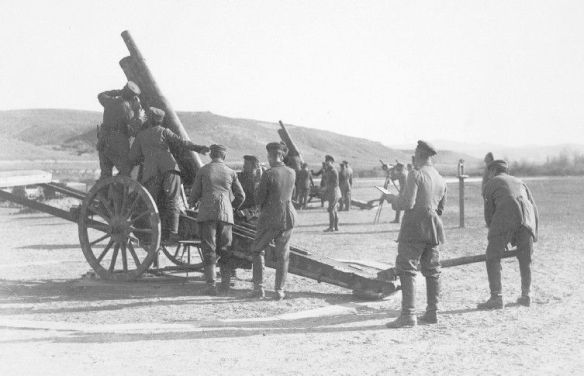German Fliegerabwehrkanoneflak, or antiaircraft artillery, known to American fliers as “flak batteries.”
At the start of World War I, dedicated antiaircraft (AA) weapons were rare. France possessed two armored cars that carried the Soixante-Quinze (75mm) field gun, and Britain had a handful of motorized 3-inch, 20-hundredweight (cwt) guns but lacked an army unit dedicated to the AA mission. Germany led the way with 6 motorized and 12 horse-drawn 77mm guns controlled by the German Army Air Service.
This paucity of AA weapons and units is not surprising, as airplanes were few and were employed primarily in unarmed aerial reconnaissance. As aircraft types matured throughout the war and aviation missions multiplied to include bombing, artillery spotting, and ground attack, however, AA weapons became increasingly important and diversified.
All powers employed machine guns as AA weapons. Germany used 37mm and 9mm versions, whereas the Allies employed 8mm Hotchkiss light machine guns mounted on tripods. Machine guns had a high rate of fire and were comparatively cheap compared to AA artillery but were ineffective above 1,000 meters (about 3,280 feet) and inherently inaccurate because of the lack of fire-control systems.
During the war, Germany continued as the leading country for AA artillery. Until 1917 its main AA gun remained the 77mm, which had a relatively low muzzle velocity of 1,600 feet per second (fps), although an 80mm gun firing at 2,600 fps was available in smaller numbers. In 1917 Germany introduced an 88mm gun (forerunner of the famed 88mm gun of World War II) with a muzzle velocity of 2,575 fps. Higher muzzle velocities enabled shorter flight times to the target and quicker response to changing altitudes and bearings for the targeted aircraft.
Germany also relied on captured Russian, Belgian, and French artillery pieces. French 75mm guns proved popular and were rebored to take German 77mm shells; Russian 3-inch field guns became the German 76.2mm flak—the German acronym for Flugzeug Abwehr Kanone (aircraft defense cannon). In 1918 nearly half of German AA artillery consisted of captured guns. The practice of converting these captured weapons accounts for the bewildering assortment of 40 types of guns and 20 different calibers that Germany employed by war’s end.
While France relied on the Soixante-Quinze (75mm) throughout the war, Britain developed a range of AA guns. The most common gun remained the 3-inch, 20 cwt with a muzzle velocity of 2,500 fps (this was also the main gun used by the United States), but the British also employed (among others) a 1-pounder “Pom-Pom” gun; a 12-pounder; a 13-pounder, 9 cwt; an 18-pounder; and a 75mm. By November 1918, Britain employed 480 AA guns to defend British airspace; more than half of these were 3-inch, 20-cwt models.
Rapid-fire artillery was only one aspect of AA weaponry. Equally important were fuzes, types of shell, searchlights, sound detectors, tethered balloons, and fire-control devices. At first, gunners set fuzes by cutting them to length. By 1917, mechanically timed fuzes enabled shells to explode after a preset time of flight. Most shells produced fragments to maximize dispersion, but high-explosive and incendiary shells (the latter dispersing chunks of flaming thermite) proved effective against larger targets such as zeppelins.
Searchlights were essential in illuminating zeppelins and bombers, thereby enabling directed AA fire at night. Sometimes the searchlights temporarily blinded pilots, leading to loss of control and crashes. Sound detectors gave enhanced warning of approaching aircraft and improved coordination among AA batteries. Tethered balloons, which could be connected to form weblike barriers, disrupted air attacks and channeled enemy aircraft into corridors defended by AA batteries.
Fire-control devices were most important to improving AA success rates. The Germans developed stereoscopic binocular systems to improve tracking and slant-range prediction; the British and French developed similar optical sights. Binocular sighting devices made feasible directed fire, which largely superseded the earlier method of barrier fire (basically, filling an area of the sky with as much lead and steel as possible).
Statistics bear out the effectiveness of time-fuzed munitions combined with improved ranging and fire directors. In 1914, German AA gunners used an average of 11,500 shells to shoot down a single aircraft; by 1918, they had cut the average to 5,040 shells. Despite improvements, AA fire control remained more art than science because of the inherent difficulties of tracking and hitting a target maneuvering in three dimensions.
In devoting the greatest resources to AA weaponry, the Germans reaped the greatest rewards. By the end of 1917, air defenses in Germany proper included 104 heavy and 112 light motorized flak guns, 998 horse-drawn and fixed flak guns, and 416 searchlights. By November 1918, the German Air Service fielded nearly 2,800 flak guns (30 percent in defense of Germany, the remainder on the Western Front) with 718 searchlights serviced by 2,800 officers and 55,000 enlisted men. Overall, Germany shot down 1,588 aircraft. The next highest national total was that of France, with about 500, while British Expeditionary Force gunners claimed 341 kills, and Italy claimed about 150 kills. U.S. AA gunners, arriving late in the war, claimed 58 kills.
Further Reading
Delsert, Bernard, Jean-Jacques Dubois, and Christian Kowal. La Flak, 1914–1918. 2 vols. Guilherand Grange, France: La Plume du Temps, 1999.
Hogg, Ian V. Anti-Aircraft: A History of Air Defense. London: Macdonald, 1978.
Hogg, Ian V. Anti-Aircraft Artillery. Marlborough, Wiltshire, UK: Crowood, 2002.
Routledge, N. W. History of the Royal Regiment of Artillery: Anti-Aircraft Artillery, 1914–55. London: Brassey’s, 1994.
Westermann, Edward B. “Fighting for the Heavens from the Ground: German Ground-Based Air Defenses in the Great War, 1914–1918.” Journal of Military History 65 (July 2001): 641–670.
Westermann, Edward B. Flak: German Anti-Aircraft Defenses, 1914–1945. Lawrence: University Press of Kansas, 2005.
